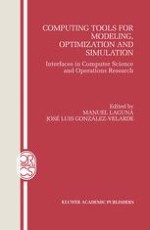Computing Tools for Modeling, Optimization and Simulation reflects the need for preserving the marriage between operations research and computing in order to create more efficient and powerful software tools in the years ahead. The 17 papers included in this volume were carefully selected to cover a wide range of topics related to the interface between operations research and computer science. The volume includes the now perennial applications of rnetaheuristics (such as genetic algorithms, scatter search, and tabu search) as well as research on global optimization, knowledge management, software rnaintainability and object-oriented modeling. These topics reflect the complexity and variety of the problems that current and future software tools must be capable of tackling. The OR/CS interface is frequently at the core of successful applications and the development of new methodologies, making the research in this book a relevant reference in the future.
The editors' goal for this book has been to increase the interest in the interface of computer science and operations research. Both researchers and practitioners will benefit from this book. The tutorial papers may spark the interest of practitioners for developing and applying new techniques to complex problems. In addition, the book includes papers that explore new angles of well-established methods for problems in the area of nonlinear optimization and mixed integer programming, which seasoned researchers in these fields may find fascinating.
